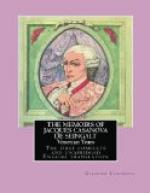“Your letter of the 30th, including your cards for my wife and myself, was delivered the first of this month by M. Casanova. He was very anxious to meet the Princess Lubomirski again at Carlsbad. But as something about his carriage was broken, he was obliged to stop in Czaslau for two hours which he passed in my company. He has left Czaslau with the promise of giving me a day on his return. I am already delighted. Even in the short space of time in which I enjoyed his company, I found in him a man worthy of our highest consideration and of our love, a benevolent philosopher whose homeland is the great expanse of our planet (and not Venice alone) and who values only the men in the kings . . . . I know absolutely no one at Carlsbad, so I sincerely regret being unable to recommend him to anyone there, according to your desire. He did not wish, on account of his haste, to pause even at Prague and, consequently, to deliver, at this time, your letter to Prince Furstemberg.”
Part the
third
dux
1786-1798
I
The castle at dux
It is uncertain how long Casanova remained at Carlsbad. While there, however, he met again the Polish nobleman Zawoiski, with whom he had gambled in Venice in 1746. “As to Zawoiski, I did not tell him the story until I met him in Carlsbad old and deaf, forty years later.” He did not return to Czaslau, but in September 1785 he was at Teplitz where he found Count Waldstein whom he accompanied to his castle at Dux.
From this time onward he remained almost constantly at the castle where he was placed in charge of the Count’s library and given a pension of one thousand florins annually.
Describing his visit to the castle in 1899, Arthur Symons writes: “I had the sensation of an enormous building: all Bohemian castles are big, but this one was like a royal palace. Set there in the midst of the town, after the Bohemian fashion, it opens at the back upon great gardens, as if it were in the midst of the country. I walked through room after room, corridor after corridor; everywhere there were pictures, everywhere portraits of Wallenstein, and battle scenes in which he led on his troops. The library, which was formed, or at least arranged, by Casanova, and which remains as he left it, contains some twenty-five thousand volumes, some of them of considerable value . . . . The library forms part of the Museum, which occupies a ground-floor wing of the castle. The first room is an armoury, in which all kinds of arms are arranged, in a decorative way, covering the ceiling and the walls with strange patterns. The second room contains pottery, collected by Casanova’s Waldstein on his Eastern travels. The third room is full of curious mechanical toys, and cabinets, and carvings in ivory. Finally, we come to the library, contained in the two innermost rooms. The book shelves are painted white and reach to the low vaulted ceilings, which are whitewashed. At the end of a bookcase, in the corner of one of the windows, hangs a fine engraved portrait of Casanova.”




